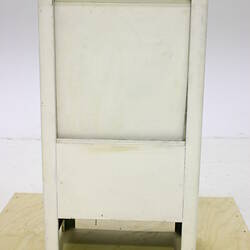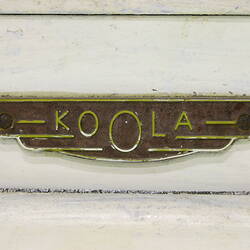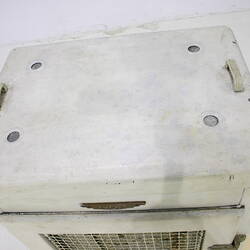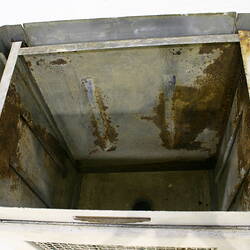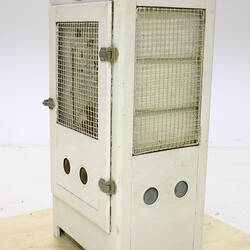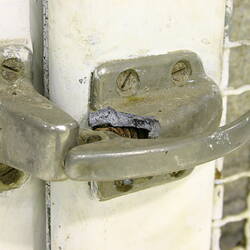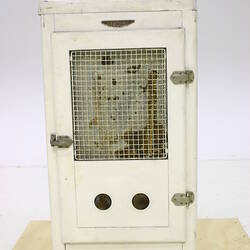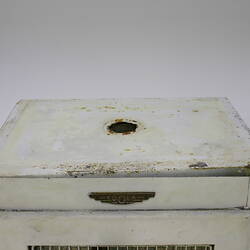Summary
Alternative Name(s): Ice Chest, Ice Box, Food Safe, Cooling Safe, Drip Safe, Cool Cabinet, Cooling Chest, Refrigerator
Koola food safe of white steel and painted wood, insulated with asbestos. Water was poured onto an upper layer of asbestos and allowed to soak down through the asbestos lined side panels. Circulating air was drawn in through various openings low in the cabinet, cooling the wet asbestos panels. This style of chest would have been used in the later inter-war and post-war periods in Australia.
The means of insulation described above was not standardised; fur pelt, hair, cork, wool, felt, ash and later asbestos were all used as insulating materials. The placement of the ice was also not standardised, though by the end of the 19th century it was generally placed in a tray at the top of the unit. A pipe for melted water ran from the ice tray to a drip tray underneath the icebox. This configuration allowed for air to circulate, enhancing the cooling effect - 'the denser cool air descending to the bottom and displacing the lighter warmer air, which rose to the top.'
Different names were popularly used for this type of refrigerator, although 'food safe' seems to have been commonly used.
Physical Description
White steel, white painted wood and wire, cooling chest. FRONT: decorative logo upper centre. DOOR: wire panel within wooden frame. Below wire panel 2 circles, with wire mesh attached from the back of the door. 2 hinges at right. Currently unable to open. HANDLE - lever style latch middle left. BACK: removable interior panel visible as wire panel missing. SIDES: rectangular panels with wire panel inserts above two circles with wire mesh, all painted white. TOP: serves as a lid. 4 circles, one in each corner, with wire mesh. HANDLES - 2, D-shaped, middle left and right. INTERIOR: hole in centre of metal tray, covered with wire mesh. INTERIOR: metal side panels, 2 vertical brackets for 2 shelves. Circular hole with upright lip centre of base. Originally had asbestos insulation on door, sides, top and back.
Significance
This food safe is significant as an example of one of the technologies used to keep food cool in Australia in the inter-war and post-war period.
This example was insulated with asbestos. Water was poured onto an upper layer of asbestos and allowed to soak down through the asbestos lined side panels. Circulating air is drawn in through various openings low in the cabinet, cooling the wet asbestos panels.
Similar Koola products were advertised in Australian newspapers from the 1930s to the 1950s. On 18 February 1938, the Advertiser (Adelaide) included the following advertisement: 'More Hot Weather Coming AND Thousands of Satisfied Users KOOLA SAFES ARE SAFE WITH WINTER TEMPER ATUHES DURING THE HOTTEST OF WEATHER. NO ICE NO ELECTRICITY. NO DRIP NO SMELL. USES WATER ONLY.' Other advertisments use the term 'Koola asbestos fridge' or 'safe', which may relate to Koola models such as this.
Ice was the principle means of refrigeration until the early 20th century. In the United States and Australia non mechanised refrigerators, iceboxes, were used to keep perishable food fresh. Iceboxes continued to be used as the primary source of refrigeration for many families into the mid 20th century. Figures from the United States show that in 1923 iceboxes outsold mechanical refrigerators but that by 1944 refrigerators were outselling iceboxes by more than two to one. (Iereley 1999: 246) Figures for Australia are less comprehensive: a survey of appliance purchases in 1923 does not include refrigerators. By 1955, refrigerators are recorded: 77% of all homes in Brisbane, 83% in Sydney, and 67% in Melbourne. By 1964, it was estimated that 94% of all Australian households owned a refrigerator. (Dingle 1998: 124)These figures are supported by recorded oral histories, which demonstrate that in Australia many families were still using iceboxes in the late 1940s and 1950s. (Coleman; The-real-keneth-williams-story; Narrative 708)
An article in the New York Mirror from 1838 provides a clear definition of the standard icebox: it 'is a double box, the outside of mahogany or other wood, and the inside of sheet-zinc [or tin], the space between being three or four inches. By filling this space with finely powdered charcoal, well packed together, the box is rendered almost heat-proof, so that a lump of ice weighing five or six pounds may be kept twenty-four to thirty-six hours, even more, if the box is not opened too often, so as to admit the hot air from without. Of course while it is closed the air contained within it, being in contact with the ice, is reduced to nearly the same temperature; and meat is preserved perfectly sweet and good, the same as in winter. The interior of the refrigerator is provided with shelves for the reception of dishes, bottles, pitchers, etc.; and thus, by very simple contrivance, joints of meat are kept good for several days, wine is cooled, butter hardened, milk saved from "turning", and a supply of ice kept on hand for the more direct use of the table.' (Quote in Ierley 1999: 168)
The means of insulation described above was not standardised; fur pelt, hair, cork, wool, felt, ash and later asbestos were all used as insulating materials. The placement of the ice was also not standardised, though by the end of the nineteenth century it was generally placed in a tray at the top of the unit. A pipe for melted water ran from the ice tray to a drip tray underneath the icebox. This configuration allowed for air to circulate, enhancing the cooling effect - 'the denser cool air descending to the bottom and displacing the lighter warmer air, which rose to the top.' (Ierley 1999: 169)
More Information
-
Collecting Areas
-
Acquisition Information
Donation from A. Clarke, 06 Dec 1977
-
Date used
Australia, 1935-1955
Dates based on newspaper advertisements for similar products, either new or second hand -
Inscriptions
FRONT: "KOOLA" in wing shaped motif.
-
Classification
Domestic life, Food & drink preservation, Cabinets - ice & water cooled
-
Category
-
Discipline
-
Type of item
-
Overall Dimensions
43 cm (Length), 55 cm (Width), 114 cm (Height)
-
Keywords
Domestic Appliances, Domestic Life, Domestic Refrigerators, Food Storage & Preservation, Household Appliances, Refrigeration

